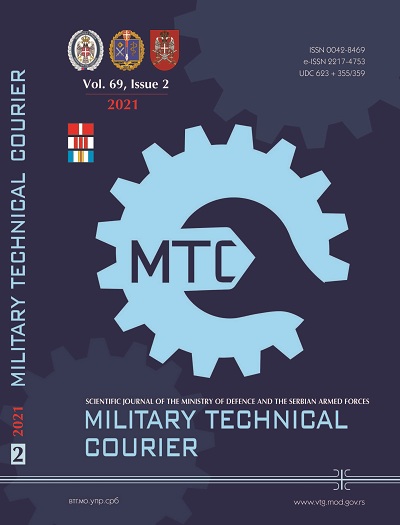Physical nature of “anomalous” electrons in high current vacuum diodes
Abstract
Introduction/purpose: A fundamental theoretical explanation is given for the fact that in subnanosecond vacuum diodes there exists a group of electrons with kinetic energies much higher than the applied voltage (multiplied by the value of the elementary charge) qUmax.
Methods: A mathematical method is used based on the numerical solution of the Vlasov-Poisson differential equations system for one-dimensional vacuum diodes of various designs.
Results: It is shown in detail that the so-called "anomalous" electrons appear in the transient time domain characterizing the processes of establishing current flow in vacuum diodes.
Conclusion: It has been convincingly shown that the presence of “anomalous” electrons is not associated with either the diode design or the presence of additional current carriers. In vacuum diodes with a subnanosecond leading edge of the voltage pulse, the excess of energy over qUmax can be over 20%.
References
Birdsall, C.K. & Langdon, A.B. 1991. Plasma Physics via Computer Simulation. Boca Raton: CRC Press. Available at: https://doi.org/10.1201/9781315275048. ISBN: 9781315275048.
Cheng, C.Z. & Knorr, G. 1976. The integration of the vlasov equation in configuration space. Journal of Computational Physics, 22(3), pp.330–351. Available at: https://doi.org/10.1016/0021-9991(76)90053-X.
Child, C.D. 1911. Discharge From Hot CaO. Physical Review (Series I), 32(5), pp.492-511. Available at: https://doi.org/10.1103/PhysRevSeriesI.32.492.
Griswold, M.E., Fisch, N.J. & Wurtele, J.S. 2012. Amended conjecture on an upper bound to time-dependent space-charge limited current. Physics of Plasmas, 19(2), art.number:024502. Available at: https://doi.org/10.1063/1.3671961.
Jaffé, G., 1944. On the Currents Carried by Electrons of Uniform Initial Velocity. Physical Review, 65(3-4), pp.91-98. Available at: https://doi.org/10.1103/PhysRev.65.91.
Kadish, A., Peter, W. & Jones, M.E. 1985. A Generalization of the Child-Langmuir Relation for One-Dimensional Time-Dependent Diodes. IEEE Transactions on Nuclear Science, 32(5), pp.2576-2578. Available at: https://doi.org/10.1109/TNS.1985.4333985.
Koh, W.S., Ang, L.K. & Kwan, T.J.T. 2005. Three-dimensional Child–Langmuir law for uniform hot electron emission. Physics of Plasmas, 12(5), art.number:053107. Available at: https://doi.org/10.1063/1.1913612.
Kozhevnikov, V.Y., Kozyrev, A.V. & Semeniuk, N.S. 2016. Kinetic modelling of the one-dimensional planar virtual cathode oscillator. In: 24th Telecommunications Forum (TELFOR), Belgrade, pp.1-4, November 22-23. Available at: https://doi.org/10.1109/telfor.2016.7818844.
Kozhevnikov, V.Y., Kozyrev, A.V. & Semeniuk, N.S. 2017. Modeling of Space Charge Effects in Intense Electron Beams: Kinetic Equation Method Versus PIC Method. IEEE Transactions on Plasma Science, 45(10), pp.2762-2766. Available at: https://doi.org/10.1109/tps.2017.2726501.
Kozyrev, A.V., Kozhevnikov, V.Yu., Baksht, E.Kh., Buranchenko, A.G. & Tarasenko, V.F. 2010. Spectrum reconstruction of a nanosecond electron beam from the data on its extinction in thin foils. Russian Physics Journal, 53(4), pp.361-368. Available at: https://doi.org/10.1007/s11182-010-9430-1.
Kozyrev, A., Kozhevnikov, V. & Semeniuk, N. 2018. Why do Electrons with “Anomalous Energies” appear in High-Pressure Gas Discharges? In: Torrisi, L. & Cutroneo, M. (Eds.) EPJ Web of Conferences, 167, art.number:01005. Available at: https://doi.org/10.1051/epjconf/201816701005.
Langmuir, I. 1913. The Effect of Space Charge and Residual Gases on Thermionic Currents in High Vacuum. Physical Review, 2(6), pp.450-486. Available at: https://doi.org/10.1103/physrev.2.450.
Langmuir, I. 1923. The Effect of Space Charge and Initial Velocities on the Potential Distribution and Thermionic Current between Parallel Plane Electrodes. Physical Review, 21(4), pp.419-435. Available at: https://doi.org/10.1103/physrev.21.419.
Lin, M-C. 2005. Space-charge effects of electrons and ions on the steady states of field-emission-limited diodes. Journal of Vacuum Science & Technology B: Microelectronics and Nanometer Structures, 23(2), art.number:636. Available at: https://doi.org/10.1116/1.1875352.
Ragan-Kelley, B., Verboncoeur, J. & Feng, Y. 2009. Two-dimensional axisymmetric Child–Langmuir scaling law. Physics of Plasmas, 16(10), art.number:103102. Available at: https://doi.org/10.1063/1.3243474.
Rokhlenko, A. & Lebowitz, J.L. 2007. Space-charge-limited, two-dimensional unmagnetized flow in a wedge geometry. Journal of Applied Physics, 102(12), art.number:123307. Available at: https://doi.org/10.1063/1.2822471.
Savitzky, A. & Golay, M.J.E. 1964. Smoothing and Differentiation of Data by Simplified Least Squares Procedures. Analytical Chemistry, 36(8), pp.1627-1639. Available at: https://doi.org/10.1021/ac60214a047.
Umeda, T., Nariyuki, Y. & Kariya, D. 2012. A non-oscillatory and conservative semi-Lagrangian scheme with fourth-degree polynomial interpolation for solving the Vlasov equation. Computer Physics Communications, 183(5), pp.1094-1100. Available at: https://doi.org//10.1016/j.cpc.2012.01.011.
Proposed Creative Commons Copyright Notices
Proposed Policy for Military Technical Courier (Journals That Offer Open Access)
Authors who publish with this journal agree to the following terms:
Authors retain copyright and grant the journal right of first publication with the work simultaneously licensed under a Creative Commons Attribution License that allows others to share the work with an acknowledgement of the work's authorship and initial publication in this journal.
- Authors are able to enter into separate, additional contractual arrangements for the non-exclusive distribution of the journal's published version of the work (e.g., post it to an institutional repository or publish it in a book), with an acknowledgement of its initial publication in this journal.
- Authors are permitted and encouraged to post their work online (e.g., in institutional repositories or on their website) prior to and during the submission process, as it can lead to productive exchanges, as well as earlier and greater citation of published work (See The Effect of Open Access).

